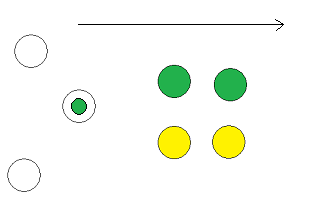
Cover
title
drawing of board circles with lines
Page 1
Introduction
Before the Game
Page 2
Components and Setup
Page 3
Rules
Page 4
Star circles
Find the Ring
Sweets
Page 5
Daring Dice and Death Dice
Dice Duel
Page 6
Dice statistics
Cover
G
A
M
A
R
O
O
an image of the board, likely with lines
Page 1
Introduction
Gamaroo is a family game where you have the classic roll dice
and move your piece down a path. Some of the spaces have challenges on them,
often questions.
The game can really be played only once.
Before the game
Page 2
Components and Setup

The image above shows the concept, but the image below shows how you would just
use circles with no board. The number of colours you use for circles depends on how
many players or teams you have.



| 3. Silly Riddle | 4. Star | 5. Word | 10. Trivia | 11. Star | 12. Riddle | |||||||||
| 1. Daring Dice | 2. Star | 17. Star | ||||||||||||
| 1. Daring Dice | 2. Star | 17. Star | ||||||||||||
| 6. Find the Ring | 7. Neighbour | 8. ? | 9. Star | 13. Body | 14. Fear | 15. Death Dice / Dice Duel | 16. Sweets |
You are encouraged to position these challenges on white circles randomly/as you see fit within their branch.
"?" is a mystery challenge.
Page 3
Rules
There are four or three players, or two teams of two (or three) players.
Individual players have five glass pieces of a particular colour, while teams
have ten pieces.
The goal is to move your pieces from off the track (not on the coloured circles) to down the track
and off the
end of the track. The first player who moves all his pieces off the track wins.
Players take turns, going clockwise around the table. A player rolls the dice, then
moves any one of his pieces that number of spaces (0-4).
No two pieces on any team can be
on the same position.
The coloured parts of the track can only be traversed by the
player who has that colour pieces.
You need to roll the exact amount, not more, to successfully get a piece off the track.

Green must roll exactly three to get the piece all the way off the track, although rolling one or two will move you to the green circles.
If you complete a challenge you roll again and move any one of your pieces.
When you land on a position that has a challenge, the relevant envelope is opened, except for stars, Sweets, Daring Dice, Death Dice
and Dice Duel.
Challenges, or at least the questions, are read out by someone who is not on the same team. There
might be something secret.
When the challenges on them have been done,
i.e. when you run out of envelopes
for a challenge, the circle is flipped over and becomes a plain, vanilla position.
Sometimes you get two questions for one challenge. You roll dice for each question answered correctly.
If you roll twice you do not move twice; you choose the best roll and move that amount.
Sweets can not be consumed during the game, unless you land on the Sweets circle.
Page 4
Stars
Find the Ring
Sweets
Page 5
Daring Dice and Death Dice
With Daring Dice
you roll a classic 1-6 die as many times as you want, and add up the numbers, e.g.
5 + 1 + 4 = 10, and once you're done rolling you can move any one of your pieces that amount.
However, if you roll a six the total is zero and your turn ends.
Don't forget that you need an exact number to be able to move a piece off the board,
so make sure the total isn't too high.
Daring Dice is done once for a player, then the circle is flipped over for that colour.
For teams, it is flipped over when each player on a team has done it once.
Death Dice is a variation of Daring Dice.
It is exactly the same as Daring Dice, but if you roll a six, the
piece that landed on Death Dice is kicked off the board and has to start over.
Death Dice is done once, then the circle is flipped over to be Dice Duel.
Dice Duel
When a player, Player A, lands on Dice Duel the player chooses an opponent, Player B.
The two players
simultaneously spend 60 seconds each building their tower of dice, one die
on top of another. The player who has the tallest standing tower specifically at the
end of the time period wins the duel, and the loser's piece is sent off the board where it will have to start all over again.
If Player A loses, the piece on the Dice Duel circle is kicked off the board. If Player B loses, Player A
chooses any of Player B's pieces to kick off the board, as long as the piece is on a white circle.
Page 6
Odds of rolling numbers:
0 - 1 in 16
1 - 1 in 4
3 - 3 in 8
3 - 1 in 4
4 - 1 in 16